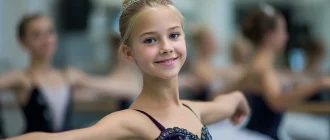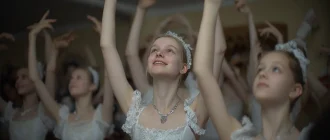Do ballet dancers wear underwear? The short answer is no, typically. The dress code in ballet class is stringent, so dancers don’t wear traditional underwear. This might seem surprising, but it’s rooted in practicality and tradition.
Ballet tights and leotards are designed to be worn without traditional underwear, ensuring a sleek silhouette and preventing discomfort. This article will explain why this practice exists, offer alternatives for extra coverage, and discuss the best undergarments for different dance contexts.
Graceful Insights
- Ballet dancers typically do not wear traditional underwear under their leotards, instead using specially designed tights for support and a sleek appearance.
- Selecting the right dance bras and undergarments is crucial for both comfort and optimal performance. Seamless designs are recommended to avoid visible lines.
- Male ballet dancers rely on dance belts for support and a smooth appearance under their tights, emphasizing the importance of proper undergarments across different dance styles.
Art de Podcast
| Category | Details |
|---|---|
| General Practice | Many ballet dancers opt not to wear traditional underwear, as it can create visible lines or cause discomfort under tight-fitting costumes like leotards or tights. |
| Alternatives Used | – Dance Belts (for Men): A supportive undergarment designed to be discreet and functional under tights. |
| – Seamless Underwear: Thin, no-show designs that prevent visible lines for women. | |
| – Built-In Options: Some costumes and leotards have built-in liners for modesty and comfort. | |
| Performance Requirements | – Costume Aesthetics: Avoiding visible lines or bulges is critical to maintaining the sleek and elegant appearance required for ballet performances. |
| – Mobility: Undergarments must not restrict movement or cause discomfort during complex choreography. | |
| Hygiene Practices | – Layering Tights: Often, tights serve as a layering piece, making traditional underwear unnecessary. |
| – Frequent Washing: Dancers maintain strict hygiene practices by washing their tights and leotards after each use. | |
| Cultural Variations | Practices may vary depending on the ballet company, region, or tradition. |
| Children & Beginners | – Young dancers are often encouraged to wear seamless underwear until they become more familiar with costume and performance demands. |
| – Schools and instructors may offer specific guidance based on training and dress codes. | |
| Common Challenges | – Chafing or Irritation: Occurs if the wrong materials are worn under tight costumes. |
| – Visibility: Improper undergarments can detract from the visual appeal of performances. | |
| Practical Tips | – Choose nude or skin-toned options that blend with the costume. |
| – Test undergarments during rehearsals to ensure comfort and functionality. |
Understanding Dance Undergarments
Dance undergarments are crucial to a dancer’s attire, providing comfort, support, and confidence during performances. These specialized garments are designed to be worn under dance costumes and leotards, ensuring the dancer’s feet can move freely without worrying about discomfort or wardrobe malfunctions.
There are various types of dance undergarments, each serving a specific purpose. For instance, dance and sports bras support female dancers, while dance belts are essential for male dancers. These undergarments are typically made from moisture-wicking materials to keep dancers dry and comfortable throughout their routines.
Choosing the right dance undergarments is essential. Seamless designs are highly recommended to avoid visible lines under tight-fitting costumes. Additionally, selecting undergarments that match the color of your ballet leotard or costume can help maintain a polished and professional appearance. Understanding the various types of dance undergarments and their purposes can help dancers select the appropriate attire to wear under their dance gear and costumes.
Do Ballet Dancers Wear Underwear?
In the structured world of ballet, the dress code is stringent. Loose-fitting items are a no-go, as the school requires dancers to don designated uniforms for class and rehearsals. This brings us to the hot topic: Do ballet dancers wear underwear? The answer is typically no. In ballet classes, female dancers usually do not wear underwear beneath their leotards; instead, they often wear nothing underneath to ensure a snug fit.
Why is this the case? Ballet tights are specifically designed to be worn without any undergarments. They provide the necessary support and coverage, eliminating the need for additional layers that could bunch up or create visible lines. For women who require extra coverage, specialized dance undergarments can be purchased to maintain the sleek look demanded by ballet.
Although this might seem unusual to some, wearing underwear under a leotard can detract from a dancer’s appearance and performance. Visible panty lines or bunching fabric can be distracting and uncomfortable. To avoid these issues, seamless undies are often recommended. A dancer who wears a leotard should carefully consider these factors.
Ballet attire is sleek, tight, and form-fitting, ensuring every movement is visible. This enables instructors to correct form and technique efficiently. The absence of traditional underwear is a practical choice, as it enhances comfort and performance. A ballet leotard complements this attire perfectly.
Choosing the Right Dance Bras

Choosing the right dance bra is as important as wearing undies or skipping traditional underwear. Dance and sports bras are designed to provide support and flexibility, which are crucial for the dynamic movements of ballet and other dance forms. Unlike standard bras, dance and sports bras are often made from moisture-wicking materials, keeping dancers dry and comfortable throughout their routines.
Functionality is key when selecting a dance bra. It should allow a full range of motion, allowing dancers to stretch, leap, and twist without discomfort. Seamless and smooth designs are highly recommended, as they ensure a discreet appearance under form-fitting costumes, such as leotards.
It’s also important to consider the transparency of your pink or black leotard. Opt for hidden colors and styles to maintain a polished and professional appearance.
Wearing Panties Underneath Your Leotard
The general rule for wearing panties under a leotard is to avoid traditional underwear. These garments, worn instead of conventional underwear or trousers, should be the first item put on before any dance activity. Choosing the right panties can prevent discomfort during movement and ensure proper support while wearing a leotard.
Many dancers mistakenly wear visible underwear under their leotards, which can detract from their overall appearance and performance. Ultimately, wearing appropriate undergarments under a leotard enhances comfort and performance, allowing the dancer to focus on their moves.
Male Ballet Dancers: The Role of Dance Belts
There, the dance belt is an essential piece of attire. Choosing a flesh-colored dance belt is crucial to ensure it remains invisible when paired with white tights. These specialized undergarments provide the necessary support and comfort during training and performances. Young men and boys are encouraged to start wearing dance belts early to develop the habit of support and comfort as they progress in their training. For male ballet dancers
The design of a dance belt helps to create a smooth appearance under tights, avoiding visible lines that could distract from a dancer’s form. Male dancers need to become accustomed to wearing these belts to perform with confidence and without discomfort.
The Importance of Proper Fit
Proper fit is essential for dance undergarments, as ill-fitting garments can cause discomfort, distraction, and even injury. When trying on dance undergarments, ensure a snug, comfortable fit for a full range of motion. This is particularly important for young dancers, who need to feel secure and confident in their attire.
An ill-fitting dance bra or belt can cause chafing, restricted movement, and inadequate support, all of which negatively impact a dancer’s performance. To avoid these issues, try different styles and sizes and observe how the undergarments feel during various dance movements.
Adjustable straps and bands can be particularly beneficial for young girls and men. They allow for a customized fit to accommodate growth and changes in body shape. Remember, the goal is to find undergarments that enhance your comfort and performance, allowing you to focus on your dance without distractions.
Undergarments for Different Types of Dance

Various dance forms require specific undergarments to ensure freedom of movement and modesty. Each style has unique needs, from professional ballet performances to contemporary and lyrical dance.
Let’s break down the specific requirements for various dance forms.
Professional Ballet Performances
In professional ballet performances, dancers wear tights, often with thongs underneath. This clothing helps create a streamlined appearance while performing. Tights come in various skin tones to remain discreet, particularly when paired with light-colored tutus.
Choosing tights that cover the body completely helps dancers maintain a seamless look. This attention to detail ensures that nothing distracts from the elegance and precision of their movements.
Contemporary and Lyrical Dance
Contemporary and lyrical dancers wear trunk bottoms or nude camisole shapers to maintain a streamlined look. These garments provide the necessary coverage without compromising flexibility, which is essential for the fluid and expressive movements characteristic of these dance styles.
Nude camisole shapers are particularly popular in lyrical dance, providing a smooth appearance under tight costumes and allowing dancers to move freely while maintaining modesty.
Ballroom and Latin Dance
In ballroom and Latin dance, wearing appropriate undergarments is essential to maintain a polished appearance under costumes. Skin-colored or black briefs are typically recommended to avoid the visibility of bare bottoms beneath costumes, ensuring a seamless and professional look.
Choosing the correct shade of undergarments is crucial to maintaining the aesthetic of ballroom and Latin costumes. This ensures that nothing detracts from the elegance and vibrancy of the performances.
Special Considerations for Young Dancers
Selecting age-appropriate undergarments is crucial for the comfort and confidence of young dancers while performing. Adjustable straps and bands in adult dance bras are essential for achieving a perfect fit and accommodating growth as young dancers develop.
Comfort is key; young dancers often opt for snug undergarments and clothing that prevents movement during routines. For those menstruating, black tights paired with black dance shorts offer additional comfort and discretion.
Practical Tips for Wearing Undergarments with Ballet Costumes

The right undergarments can make a world of difference in ballet costumes. Dancers generally favor thong-style dance belts, which do not leave visible lines and maintain a clean aesthetic. Opt for undergarments that match the color of your costume to maintain a seamless look on stage.
Performance fabric undergarments can enhance comfort and prevent distractions while dancing. A dance belt’s design helps create a smooth appearance under tights, avoiding visible lines that could distract from a dancer’s form.
Lastly, always test your pants and leotards for comfort and coverage in various positions to avoid wardrobe malfunctions during performances, even if you’re wearing just a leotard.
Common Mistakes and How to Avoid Them
Avoiding common mistakes can significantly improve your dance experience. Poorly fitting underwear can lead to discomfort during practice or performances, so always choose snug-fitting options. Not wearing underwear under a leotard can enhance comfort and help avoid visible lines or potential wardrobe malfunctions.
Resume
Proper dance undergarments are crucial for both comfort and performance. From the specific needs of ballet to the unique requirements of contemporary and ballroom dance, choosing the right undergarments can make all the difference. Remember, the goal is to ensure that nothing detracts from the beauty and precision of your movements. Happy dancing!
FAQ
What do ballet dancers wear when extra coverage is needed for complicated lifts?
Ballerinas often choose seamless ballet underwear or skin-tone dance briefs that sit higher on the hip, so a partner’s grip never catches excess fabric.
How do male ballet dancers adjust a dance belt to stay comfortable on stage?
A properly fitted dance belt sits low on the hips with the waistband parallel to the floor; dancers pull the thong section snug to keep the front padded cup centered and motion-free during jumps.
Are compression shorts acceptable underwear for dancers during rehearsal?
Thin, high-stretch compression shorts designed for dance can provide mild muscle support, but they must be matte and inseam-free to avoid showing through tights.
What kind of undergarments are recommended for young ballet students?
Child dancers typically wear convertible tights as underwear; if extra coverage is needed, teachers recommend lightweight, nude-toned briefs with flat seams for added support.
How often should a male dancer replace his dance belt?
With daily use, most dance belts lose elasticity in six to nine months; visible fraying or a looser waistband signals it’s time for a new one.
Which fabrics help prevent chafing when dancers choose underwear?
Moisture-wicking micro-modal blends and soft bamboo viscose reduce friction under tights better than standard cotton.
How do dancers secure microphone packs without visible straps?
Small wireless packs slide into hidden pockets sewn inside tights or into a low-profile stretch belt worn at the waist, avoiding bulky underwear bands.
Can dancers wear underwear beneath a unitard or full-body costume?
Yes, but they stick to seamless thong-style briefs or a flesh-tone dance belt to keep the long vertical lines of the unitard completely smooth.
What underwear options exist for dancers with sensitive skin?
Hypoallergenic briefs made from undyed silk or organic cotton offer breathability and reduce contact irritation under synthetic tights.
How do touring ballet companies care for specialized underwear on the road?
After each performance, wardrobe crews hand-wash dance belts and briefs with mild detergent, then lay them flat overnight to preserve shape and elasticity.
Do temperature changes affect a ballet dancer’s decision to wear underwear?
In cold theaters, some dancers add a thin moisture-wicking layer for warmth, while in hot climates they often skip underwear entirely to stay cool.
How do non-binary dancers decide between a dance belt and other supportive garments?
They choose based on choreography and comfort—some prefer a softer compression brief, while others select a low-rise dance belt for secure support under tights.
What features distinguish ballet underwear from everyday athletic briefs?
Dance-specific underwear uses ultra-flat seams, minimal waistbands, and stretch mesh panels to remain invisible beneath stage lighting.
Is it safe to practice pointe work without wearing any underwear?
If the tights are clean and properly fitted, additional layers can bunch at the hip crease, restricting ankle articulation.
Are there eco-friendly brands producing underwear for ballet dancers?
Several small labels now offer biodegradable bamboo dance belts and recycled polyamide briefs that meet sustainability standards without compromising fit.
What emergency fixes do wardrobe staff use when underwear lines appear minutes before the curtain?
Backstage, the quick-change kit applies body adhesive to flatten seams or switch the dancer to a no-show thong.
How should dancers wash a dance belt to maintain hygiene and elasticity?
Hand-wash in lukewarm water with gentle soap, rinse thoroughly, roll in a towel to remove excess moisture, and air-dry away from direct heat.
Can male ballet dancers perform without a dance belt in contemporary pieces?
Some contemporary works allow soft compression shorts instead, but most companies still require a dance belt to protect and support the anatomy during lifts.
Do ballerinas ever wear bras under their leotards for additional support?
Dancers with larger busts opt for low-back, clear-strap sports bras or built-in shelf bras sewn into the leotard to maintain clean lines.
What do male ballet dancers wear under their tights during class versus performance?
They may choose a thinner practice dance belt for flexibility in class, switching to a molded performance belt with extra padding for onstage partnering.








